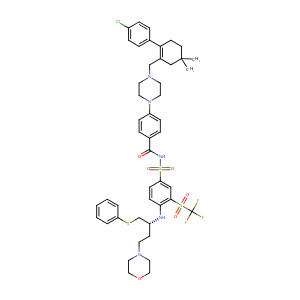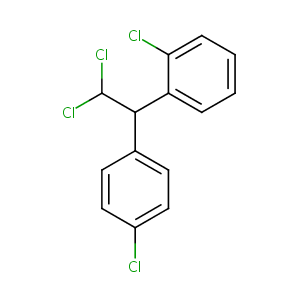| 1 |
Loss of function mutations in VARS encoding cytoplasmic valyl-tRNA synthetase cause microcephaly, seizures, and progressive cerebral atrophy.Hum Genet. 2018 Apr;137(4):293-303. doi: 10.1007/s00439-018-1882-3. Epub 2018 Apr 24.
|
| 2 |
ClinicalTrials.gov (NCT04472598) Study of Oral Navitoclax Tablet In Combination With Oral Ruxolitinib Tablet When Compared With Oral Ruxolitinib Tablet To Assess Change In Spleen Volume In Adult Participants With Myelofibrosis (TRANSFORM-1). U.S. National Institutes of Health.
|
| 3 |
URL: http://www.guidetopharmacology.org Nucleic Acids Res. 2015 Oct 12. pii: gkv1037. The IUPHAR/BPS Guide to PHARMACOLOGY in 2016: towards curated quantitative interactions between 1300 protein targets and 6000 ligands. (Ligand id: 8319).
|
| 4 |
Small molecules, big targets: drug discovery faces the protein-protein interaction challenge.Nat Rev Drug Discov. 2016 Aug;15(8):533-50.
|
| 5 |
URL: http://www.guidetopharmacology.org Nucleic Acids Res. 2015 Oct 12. pii: gkv1037. The IUPHAR/BPS Guide to PHARMACOLOGY in 2016: towards curated quantitative interactions between 1300 protein targets and 6000 ligands. (Ligand id: 6957).
|
| 6 |
Clinical pipeline report, company report or official report of Roche (2009).
|
| 7 |
Clinical pipeline report, company report or official report of the Pharmaceutical Research and Manufacturers of America (PhRMA)
|
| 8 |
The B-cell lymphoma 2 (BCL2)-inhibitors, ABT-737 and ABT-263, are substrates for P-glycoprotein. Biochem Biophys Res Commun. 2011 May 6;408(2):344-9.
|
| 9 |
Effect of rifampin on the pharmacokinetics, safety and tolerability of navitoclax (ABT-263), a dual inhibitor of Bcl-2 and Bcl-XL , in patients with cancer. J Clin Pharm Ther. 2014 Dec;39(6):680-4.
|
| 10 |
Human breast cancer cells display different sensitivities to ABT-263 based on the level of survivin. Toxicol In Vitro. 2018 Feb;46:229-236. doi: 10.1016/j.tiv.2017.09.023. Epub 2017 Sep 23.
|
| 11 |
BCL2/BCL-X(L) inhibition induces apoptosis, disrupts cellular calcium homeostasis, and prevents platelet activation. Blood. 2011 Jun 30;117(26):7145-54. doi: 10.1182/blood-2011-03-344812. Epub 2011 May 11.
|
| 12 |
Mitotane for adrenocortical carcinoma treatment. Curr Opin Investig Drugs. 2005 Apr;6(4):386-94.
|
| 13 |
Biphasic hormonal responses to the adrenocorticolytic DDT metabolite 3-methylsulfonyl-DDE in human cells. Toxicol Appl Pharmacol. 2010 Feb 1;242(3):281-9.
|
| 14 |
Mitotane exhibits dual effects on steroidogenic enzymes gene transcription under basal and cAMP-stimulating microenvironments in NCI-H295 cells. Toxicology. 2012 Aug 16;298(1-3):14-23.
|
| 15 |
Differential effect of DDT, DDE, and DDD on COX-2 expression in the human trophoblast derived HTR-8/SVneo cells. J Biochem Mol Toxicol. 2012 Nov;26(11):454-60.
|
| 16 |
Mitotane induces CYP3A4 expression via activation of the steroid and xenobiotic receptor. J Endocrinol. 2013 Feb 15;216(3):297-305.
|
| 17 |
The effect of mitotane on viability, steroidogenesis and gene expression in NCI295R adrenocortical cells. Mol Med Rep. 2013 Mar;7(3):893-900.
|
| 18 |
Mitotane alters mitochondrial respiratory chain activity by inducing cytochrome c oxidase defect in human adrenocortical cells. Endocr Relat Cancer. 2013 May 21;20(3):371-81.
|
| 19 |
Identification of novel agonists by high-throughput screening and molecular modelling of human constitutive androstane receptor isoform 3. Arch Toxicol. 2019 Aug;93(8):2247-2264. doi: 10.1007/s00204-019-02495-6. Epub 2019 Jul 16.
|
| 20 |
Development of a recombinant human ovarian (BG1) cell line containing estrogen receptor and for improved detection of estrogenic/antiestrogenic chemicals. Environ Toxicol Chem. 2016 Jan;35(1):91-100. doi: 10.1002/etc.3146. Epub 2015 Dec 9.
|
| 21 |
Mitotane has an estrogenic effect on sex hormone-binding globulin and corticosteroid-binding globulin in humans. J Clin Endocrinol Metab. 2006 Jun;91(6):2165-70. doi: 10.1210/jc.2005-2157. Epub 2006 Mar 21.
|
| 22 |
Recombinant human estrogen, androgen and progesterone receptors for detection of potential endocrine disruptors. Anal Bioanal Chem. 2004 Feb;378(3):664-9. doi: 10.1007/s00216-003-2251-0. Epub 2003 Oct 25.
|
| 23 |
Effects of mitotane on gene expression in the adrenocortical cell line NCI-H295R: a microarray study. Pharmacogenomics. 2012 Sep;13(12):1351-61. doi: 10.2217/pgs.12.116.
|
| 24 |
Organochlorine-mediated potentiation of the general coactivator p300 through p38 mitogen-activated protein kinase. Carcinogenesis. 2009 Jan;30(1):106-13. doi: 10.1093/carcin/bgn213. Epub 2008 Sep 12.
|
| 25 |
Ribonucleotide reductase large subunit (RRM1) gene expression may predict efficacy of adjuvant mitotane in adrenocortical cancer. Clin Cancer Res. 2012 Jun 15;18(12):3452-61. doi: 10.1158/1078-0432.CCR-11-2692. Epub 2012 Apr 30.
|
| 26 |
Agonistic effects of diverse xenobiotics on the constitutive androstane receptor as detected in a recombinant yeast-cell assay. Toxicol In Vitro. 2018 Feb;46:335-349. doi: 10.1016/j.tiv.2017.09.014. Epub 2017 Sep 18.
|
| 27 |
The organochlorine o,p'-DDT plays a role in coactivator-mediated MAPK crosstalk in MCF-7 breast cancer cells. Environ Health Perspect. 2012 Sep;120(9):1291-6. doi: 10.1289/ehp.1104296. Epub 2012 May 18.
|
| 28 |
Interferon- is a potent inhibitor of cell growth and cortisol production in vitro and sensitizes human adrenocortical carcinoma cells to mitotane. Endocr Relat Cancer. 2013 May 30;20(3):443-54. doi: 10.1530/ERC-12-0217. Print 2013 Jun.
|
|
|
|
|
|
|


